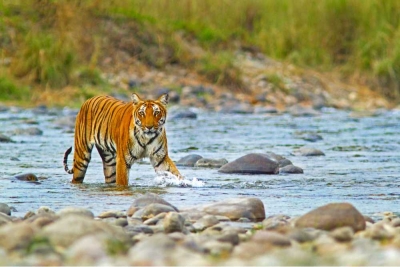
The oldest national park in the country, Jim Corbett National Park covers an area of more than 500 sq km and is located in Uttarakhand. It was known as Hailey National Park before it was renamed in the 1950s after hunter-turned-conservationist James Edward Corbett (popularly known as Jim Corbett), who played a significant role in setting it up. The Park is part of the larger Tiger Reserve of the same name. Located on the Himalayan foothills, the Park has streams and rivers running through it, helping nurture the varied landscapes there from rugged forests to grasslands. This mosaic of vegetation has also served as a magnet for several species of birds and animals. The region is noted especially for its tiger and elephant population. In fact, Corbett has the highest number of tigers in the country – 213, according to the report of the fourth All India Tiger Estimation 2018 released on the eve of Global Tiger Day (July 29), 2020. Corbett hosts more than 550 species of birds, and has been declared an “Important Bird Area” by Birdlife International.
Wildlife
The birds found in the region include pelicans, darters, cormorants, grebes, storks, ibises, pochards, shelducks, hawks, grions, harriers, falcons, kestrels, francolins. partridges, quails, pheasants, crakes, swamphens, moorhens, watercocks, jacanas, lapwings, plovers, sandpipers, snipes, stints, redshanks, coucals, nightjars, hornbills, barbets, woodpeckers, martins, magpies, minivets, fantails, warblers, prinias, robins, tits, nuthatches, wagtails, weavers, and buntings. Apart from the Royal Bengal tiger and the Asiatic elephant, one may spot the gharial, sloth bear, Himalayan black bear, hog deer, sambar, marsh crocodile, rhesus macaque, mongoose, otter, jackal, pangolin, python and the cobra too.
Hello, rhinos!
Though famed for its tigers, Corbett is all set to welcome a new kind of inhabitant – Assam’s famed one-horned rhinoceros. In November 2019, the Uttarakhand Wildlife Advisory Board approved a proposal for rhino translocation on an experimental basis. As part of the proposal, more than one dozen rhinos from the Kaziranga National Park will find a home in Uttarakhand’s most popular National Park. It is said that the region is conducive for the mammals, and is also less plagued by human-animal conflict. Reports suggest that Corbett was perhaps a natural habitat of the pachyderms since a male rhino was sighted towards the end of the 18th Century. What inspired the proposal could be the similar translocation and eventual success of nearly half-a-dozen rhinos from Assam’s Pobitora to Uttar Pradesh’s Dudhwa National Park way back in 1984.
Popularity is a threat…
• The Park has for long received a large number of visitors. While tourism is integral to the development of any natural habitat it cannot be at the cost of the region itself. The huge number of visitors, infrastructure development around the Park to host these visitors, the clearing of land to set up activities for the tourists, the dumping of garbage into the river flowing through the Park etc. are among the greatest threats to the Park With increasing number of visitors, the chances of human animal conflicts too increase. drawing attention to the need to find a healthy balance between tourism and income generation for the region.
• This February, more than a month before the COVD-19 pandemic gripped the country, a photograph shot inside the Corbett Tiger Reserve went viral on social media It showed two tigers playing with what appears to be a plastic object. Indicative of how much plastic has invaded eco-sensitive regions, conservationists termed it a tragedy and called for public awareness and sensitivity. Ironically, plastic is banned in the Reserve.
• In 2016, Uttarakhand experienced one of its worst forest fires in recent times. Among several other areas Corbett too suffered. It was reported that about 200 hectares of forests were reduced to ashes. Though animal deaths were not reported forest fires can push escaping animals into human habitation leading to conflicts. Worse, several adult and young animals could perish or be injured significantly reducing the chances of new generations of animals to survive and grow, and leaving existing populations vulnerable.
Picture Credit : Google

